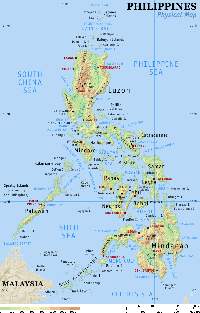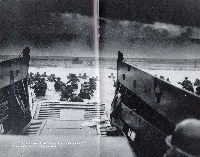Canadian National Aboriginal Day
From Wikipedia, the free encyclopediaNational Aboriginal Day is a Canadian day of recognition of the diverse cultures and outstanding contributions to Canada of the First Nations, Inuit and Métis, who are collectively known as Aboriginal peoples in Canada. It was proclaimed in 1996 by then Governor General of Canada Roméo LeBlanc to be celebrated on June 21 of every year.
The day of June 21 was selected for several reasons. In 1982 the National Indian Brotherhood (now the Assembly of First Nations) called for the creation of a National Aboriginal Solidarity Day to be celebrated on June 21. Slightly more than a decade later in 1995, the Royal Commission on Aboriginal Peoples recommended that a National First Peoples Day be designated. Also in that same year a national conference of Aboriginal and non-Aboriginal people chaired by Elijah Harper titled The Sacred Assembly called for a national holiday to celebrate the contributions of Aboriginal peoples to Canada. Lastly, June 21 coincides with the summer solstice.
The first National Aboriginal Day was celebrated on June 21 in 1996 and it has been celebrated on that day annually ever since. It is now part of a series of "Celebrate Canada" days, beginning with National Aboriginal Day and being followed by St-Jean Baptiste Day on June 24, Canadian Multiculturalism Day on June 27, and concluding with Canada Day on July 1.
FAQ on aboriginal Canadians:
How many aboriginal Canadians are there in Canada?In 2000, there were 675,499 aboriginal Canadians in Canada. This includes registered Indians, Metis, and Inuit peoples.
How many live on and off reserves?
There were 391,993 aboriginal people (58 per cent) living on the reserve and 283,506 (42 per cent) living off the reserve in 2000.
Where do aboriginal people live in Canada?
In 2000, nearly a quarter (23 per cent) of the aboriginal population lived in Ontario, the largest proportion of all of the regions. Only one per cent of the aboriginal population lives in the Yukon, the smallest proportion of all of the regions. Nunavut has the fastest growing aboriginal population in Canada.
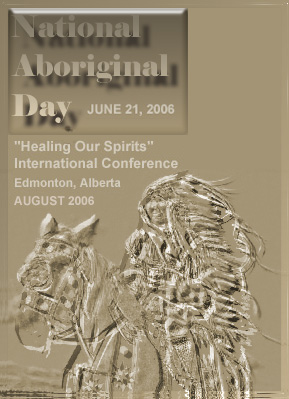
Extending from now through the summer, various powwows will be held all over the United States and Canada by Native Americans. I'll put up new ones as I find out about them - take the kids and grandkids to one near you, learn and enjoy! The Healing Our Spirits International Conference will take place August 5-11.
Summer SolsticeJune 21, 2006 - 8:26 a.m. EDT, 12:26 UT |
||
|
Ancient Celts: Druids, the priestly/professional/diplomatic corps in Celtic countries, celebrated Alban Heruin ("Light of the Shore"). It was midway between the spring Equinox (Alban Eiler; "Light of the Earth") and the fall Equinox (Alban Elfed; "Light of the Water"). "This midsummer festival celebrates the apex of Light, sometimes symbolized in the crowning of the Oak King, God of the waxing year. At his crowning, the Oak King falls to his darker aspect, the Holly King, God of the waning year..." 13 The days following Alban Heruin form the waning part of the year because the days become shorter.
|
||
|
|
Ancient China: Their summer solstice ceremony celebrated the earth, the feminine, and the yin forces. It complemented the winter solstice which celebrated the heavens, masculinity and yang forces.
|
|
|
|
Ancient Gaul: The Midsummer celebration was called Feast of Epona, named after a mare goddess who personified fertility, sovereignty and agriculture. She was portrayed as a woman riding a mare.
|
|
|
|
Ancient Germanic, Slav and Celtic tribes in Europe: Ancient Pagans celebrated Midsummer with bonfires. "It was the night of fire festivals and of love magic, of love oracles and divination. It had to do with lovers and predictions, when pairs of lovers would jump through the luck-bringing flames..." It was believed that the crops would grow as high as the couples were able to jump. Through the fire's power, "...maidens would find out about their future husband, and spirits and demons were banished." Another function of bonfires was to generate sympathetic magic: giving a boost to the sun's energy so that it would remain potent throughout the rest of the growing season and guarantee a plentiful harvest.
|
|
|
|
Ancient Rome: The festival of Vestalia lasted from JUN-7 to JUN-15. It was held in honor of the Roman Goddess of the hearth, Vesta. Married women were able to enter the shrine of Vesta during the festival. At other times of the year, only the vestal virgins were permitted inside.
|
|
|
|
Ancient Sweden: A Midsummer tree was set up and decorated in each town. The villagers danced around it. Women and girls would customarily bathe in the local river. This was a magical ritual, intended to bring rain for the crops.
|
|
|
|
Christian countries: After the conversion of Europe to Christianity, the feast day of St. John the Baptist was set as JUN-24. It "is one of the oldest feasts, if not the oldest feast, introduced into both the Greek and Latin liturgies to honour a saint." Curiously, the feast is held on the alleged date of his birth. Other Christian saints' days are observed on the anniversary of their death. The Catholic Encyclopedia explains that St. John was "filled with the Holy Ghost even from his mother's womb...[thus his] birth...should be signalized as a day of triumph." His feast day is offset a few days after the summer solstice, just as Christmas is fixed a few days after the winter solstice. "Just as John was the forerunner to Jesus, midsummer forecasts the eventual arrival of" the winter solstice circa DEC-21.
|
|
|
|
Essenes: This was a Jewish religious group active in Palestine during the 1st century CE. It was one of about 24 Jewish groups in the country -- the only one that used a solar calendar. Other Jewish groups at the time included the Sadducees, Pharisees, Zealots, followers of John, and followers of Yeshua (Jesus). Archaeologists have found that the largest room of the ruins at Qumran (location of the Dead Sea Scrolls) appears to be a sun temple. The room had been considered a dining room by earlier investigators, in spite of the presence of two altars at its eastern end. At the time of the summer solstice, the rays of the setting sun shine at 286 degrees along the building's longitudinal axis, and illuminate the eastern wall. The room is oriented at exactly the same angle as the Egyptian shrines dedicated to the sun. Two ancient authorities -- the historian Josephus and the philosopher Filon of Alexandria -- had written that the Essenes were sun worshipers. Until now, their opinion had been rejected by modern historians.
|
|
|
|
Native Americans
|
|
|
|
The Natchez tribe in the southern U.S. "worshiped the sun and believed that their ruler was descended from him. Every summer they held a first fruits ceremony." Nobody was allowed to harvest the corn until after the feast.
|
|
|
|
Males in the Hopi tribe dressed up as Kachinas - the dancing spirits of rain and fertility who were messengers between humanity and the Gods. At Midsummer, the Kachinas were believed to leave the villages to spend the next six months in the mountains, where they were believed to visit the dead underground and hold ceremonies on their behalf.
|
|
|
|
Native Americans have created countless stone structures linked to equinoxes and solstices. Many are still standing. One was called Calendar One by its modern-day finder. It is in a natural amphitheatre of about 20 acres in size in Vermont. From a stone enclosure in the center of the bowl, one can see a number of vertical rocks and other markers around the edge of the bowl "At the summer solstice, the sun rose at the southern peak of the east ridge and set at a notch at the southern end of the west ridge." The winter solstice and the equinoxes were similarly marked.
|
|
|
|
The Bighorn Medicine Wheel west of Sheridan, WY is perhaps the most famous of the 40 or more similar "wheels" on the high plains area of the Rocky Mountains. Most are located in Canada. At Bighorn, the center of a small cairn, that is external to the main wheel, lines up with the center of the wheel and the sun rising at the summer equinox. Another similar sighting cairn provides a sighting for three dawn-rising stars: Aldebaran, Rigel and Sirius. A third cairn lines up with fourth star: Fomalhaut. The term "medicine wheel" was coined by Europeans; it was a term used to describe anything native that white people didn't understand.
|
|
|
|
Neopaganism: This is a group of religions which are attempted re-constructions of ancient Pagan religions. Of these, Wicca is the most common; it is loosely based partly on ancient Celtic beliefs and practices. Wiccans recognize eight seasonal days of celebration. Four are minor sabbats and occur at the two solstices and the two equinoxes. The other are major sabbats which happen approximately halfway between an equinox and solstice. The summer solstice sabbat is often called Midsummer or Litha. Wiccans may celebrate the sabbat on the evening before, at sunrise on the morning of the solstice, or at the exact time of the astronomical event.
"Midsummer is the time when the sun reaches the peak of its power, the earth is green and holds the promise of a bountiful harvest. The Mother Goddess is viewed as heavily pregnant, and the God is at the apex of his manhood and is honored in his guise as the supreme sun."
It is a time for divination and healing rituals. Divining rods and wands are traditionally cut at this time.
|
|
|
|
Prehistoric Europe: Many remains of ancient stone structures can be found throughout Europe. Some date back many millennia BCE. Many appear to have religious/astronomical purposes; others are burial tombs. These structures were built before writing was developed. One can only speculate on the significance of the summer solstice to the builders. Perhaps the most famous of these structures is Stonehenge, a megalith monument on Salisbury Plain in Wiltshire. It was built in three stages, between circa 3000 and 1500 BCE. "The circular bank and ditch, double circle of 'bluestones' (spotted dolerite), and circle of sarsen stones (some with white lintels), are concentric, and the main axis is aligned on the midsummer sunrise--an orientation that was probably for ritual rather than scientific purposes. Four "station stones" within the monument form a rectangle whose shorter side also points in the direction of the midsummer sunrise.
|
|
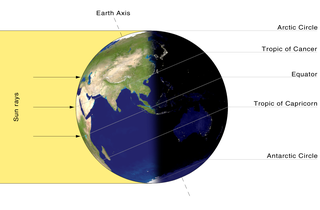
Illumination of Earth by the sun on the northern hemisphere summer solstice
Solar Center - Stanford - discussion of Medicine Wheel
Sun-Earth website - NASA, discussion of Bighorn Medicine Wheel in Wyoming and other ancient observatories
and Google for celebrations in your area, from Santa Barbara, Calabasas and Philadelphia to Ontario and Stonehenge
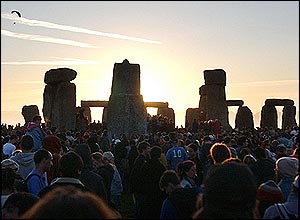 21,000 attend Stonehenge Summer Solstice celebration 2005. Note the para-sailor observing the crowd.
21,000 attend Stonehenge Summer Solstice celebration 2005. Note the para-sailor observing the crowd.

